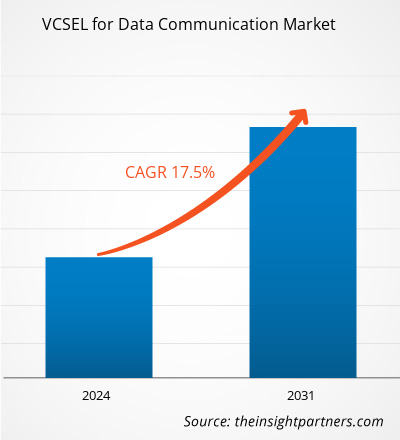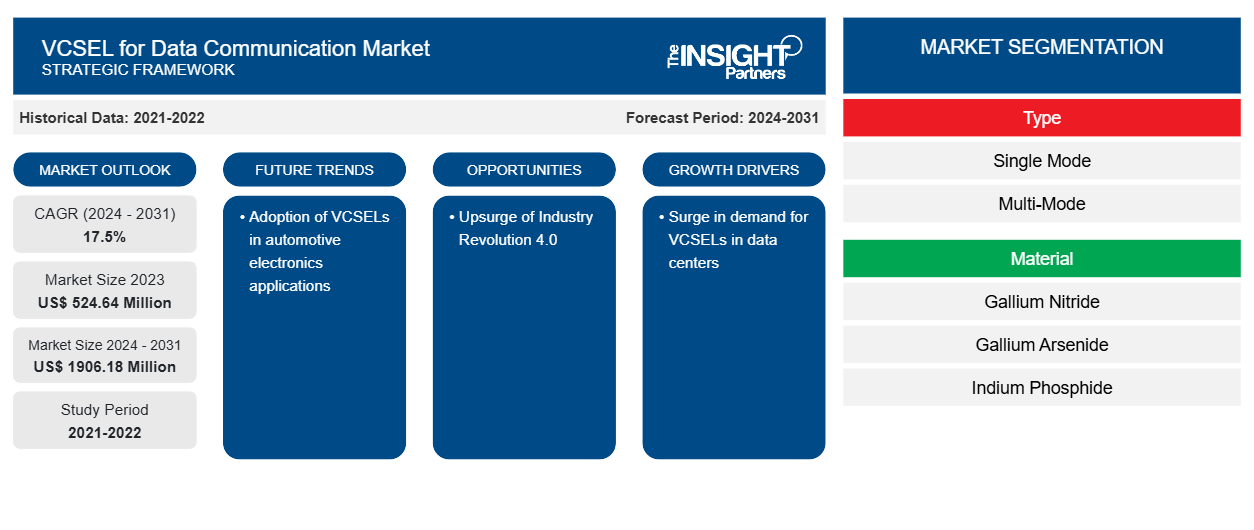Der Markt für VCSELs zur Datenkommunikation soll von 524,64 Millionen US-Dollar im Jahr 2023 auf 1.906,18 Millionen US-Dollar im Jahr 2031 wachsen; von 2024 bis 2031 wird eine durchschnittliche jährliche Wachstumsrate von 17,5 % erwartet. Der Einsatz von VCSELs in Automobilelektronikanwendungen dürfte ein wichtiger Markttrend für VCSELs zur Datenkommunikation bleiben.
VCSEL für die Datenkommunikation – Marktanalyse
Der Aufstieg der Industrierevolution 4.0, einschließlich Technologien wie Automatisierung, künstliche Intelligenz und das Internet der Dinge (IoT), hat zum Wachstum des VCSEL-Marktes für die Datenkommunikation beigetragen.
VCSEL für die Datenkommunikation – Marktübersicht
Ein Vertical-Cavity Surface Emitting Laser (VCSEL) ist eine halbleiterbasierte Laserdiode, die einen starken Laserstrahl vertikal von ihrer Oberfläche aus erzeugt. Diese Geräte erfreuen sich in vielen Bereichen großer Beliebtheit, insbesondere bei Netzwerkanwendungen. VCSELs haben einen Wellenlängenbereich von 850 nm bis 1310 nm und können Daten mit Geschwindigkeiten von 2,125 Gbps bis 150 Gbps übertragen. Sie bieten eine einzigartige Kombination aus hoher Leistungsdichte, kleiner Verpackung, schmaler spektraler Breite und schneller Bedienung. Im Vergleich zu typischen Laserdioden sind VCSELs weniger anfällig für Temperaturschwankungen. Die überwiegende Mehrheit der im Handel erhältlichen VCSELs arbeitet bei 850 nm und ist speziell auf die strengen Anforderungen der Hochgeschwindigkeitsdatenübertragung ausgelegt
Passen Sie diesen Bericht Ihren Anforderungen an
Sie erhalten kostenlos individuelle Anpassungen an jedem Bericht, einschließlich Teilen dieses Berichts oder einer Analyse auf Länderebene, eines Excel-Datenpakets sowie tolle Angebote und Rabatte für Start-ups und Universitäten.
-
Holen Sie sich die wichtigsten Markttrends aus diesem Bericht.Dieses KOSTENLOSE Beispiel umfasst eine Datenanalyse von Markttrends bis hin zu Schätzungen und Prognosen.
VCSEL für die Datenkommunikation – Markttreiber und Chancen
Nachfrageschub für VCSELs in Rechenzentren begünstigt Markt
Rechenzentren sind kritische Komponenten der Internet-Infrastruktur und dienen als Speicher-, Rechen- und Datenzugriffspunkte. Der Bedarf an VCSELS in Rechenzentren steigt und treibt die Expansion des VCSEL-Marktes für die Datenkommunikation voran. VCSELS werden in Rechenzentren für eine Vielzahl von Zwecken eingesetzt, darunter Hochgeschwindigkeitsdatenübertragung, optische Verbindungen und Sensorik. Sie haben hohe Datengeschwindigkeiten, einen geringen Stromverbrauch und eine geringe Größe, was sie ideal für den Rechenzentrumsbetrieb macht. Mehrere Gründe tragen zur erhöhten Nachfrage nach VCSELS in Rechenzentren bei. Einer der Hauptgründe ist die Ausbreitung des Internets und der wachsende Bedarf an Datenspeicher- und Verarbeitungskapazität.
Aufschwung der Industrierevolution 4.0
Der Beginn der Industrierevolution 4.0 hat zu erheblichen Fortschritten in Technologien wie Automatisierung, künstlicher Intelligenz und dem Internet der Dinge (IoT) geführt. Diese Technologien haben einen erheblichen Einfluss auf eine Vielzahl von Sektoren gehabt, darunter das VCSEL-Datenübertragungsgeschäft. Industrie 4.0, auch bekannt als die vierte industrielle Revolution, zeichnet sich durch die Integration digitaler, physischer und biologischer Systeme aus. Dabei werden innovative Technologien eingesetzt, um intelligente Fabriken zu entwickeln und Herstellungsprozesse zu optimieren. Eines der Hauptziele von Industrie 4.0 ist die Erreichung einer IoT-gestützten Produktionsoptimierung in intelligenten Fabriken. Dies bedeutet, dass Geräte, Vorrichtungen und Systeme über das Internet miteinander verbunden sind und miteinander interagieren, was eine Datenerfassung und -analyse in Echtzeit ermöglicht.IoT). These technologies have had a significant influence on a variety of sectors, including the VCSEL data transmission business. Industry 4.0, also known as the Fourth Industrial Revolution, is distinguished by the integration of digital, physical, and biological systems. It entails using innovative technology to develop smart factories and optimize manufacturing processes. One of the primary objectives of Industry 4.0 is to achieve IoT-enabled production optimization in smart factories. This implies that equipment, devices, and systems are connected and interact with one another over the Internet, allowing for real-time data collection and analysis.
VCSEL für die Datenkommunikation Marktbericht Segmentierungsanalyse
Wichtige Segmente, die zur Ableitung des Marktanalysetyps und -materials für VCSEL für Datenkommunikation beigetragen haben.
- Je nach Typ ist der Markt in Singlemode und Multimode unterteilt. Das Multimode-Segment hatte im Jahr 2023 einen größeren Marktanteil.
- Basierend auf dem Material ist der Markt in Galliumnitrid, Galliumarsenid, Indiumphosphid und andere unterteilt. Das Segment Galliumarsenid hatte im Jahr 2023 einen größeren Marktanteil.
VCSEL für die Datenkommunikation – Marktanteilsanalyse nach Geografie
Der geografische Umfang des VCSEL-Marktberichts für die Datenkommunikation ist hauptsächlich in fünf Regionen unterteilt: Nordamerika, Asien-Pazifik, Europa, Naher Osten und Afrika sowie Südamerika/Süd- und Mittelamerika. Nordamerika dominierte den VCSEL-Markt für die Datenkommunikation im Jahr 2023. Nordamerika hat Innovationen bei fortschrittlichen Technologien erlebt, die zum Wachstum des VCSEL-Marktes für die Datenkommunikation in der Region beigetragen haben. Darüber hinaus hat die steigende Nachfrage nach Datenkommunikationsanwendungen das Wachstum des VCSEL-Marktes in Nordamerika angekurbelt. Insbesondere Rechenzentren haben die Nachfrage nach VCSELs angetrieben, da sie eine entscheidende Komponente der Internetinfrastruktur für Speicherung, Berechnung und Datenzugriff sind.fuelled the growth of the VCSEL market in North America. Data centers, in particular, have driven the demand for VCSELs, as they are a crucial component of internet infrastructure for storage, computation, and data access.
Regionale Einblicke in den VCSEL-Markt für Datenkommunikation
Die regionalen Trends und Faktoren, die den VCSEL-Markt für Datenkommunikation im gesamten Prognosezeitraum beeinflussen, wurden von den Analysten von Insight Partners ausführlich erläutert. In diesem Abschnitt werden auch die Marktsegmente und die Geografie von VCSEL-Markt für Datenkommunikation in Nordamerika, Europa, im asiatisch-pazifischen Raum, im Nahen Osten und Afrika sowie in Süd- und Mittelamerika erörtert.

- Erhalten Sie regionale Daten zum VCSEL-Markt für die Datenkommunikation
Umfang des Marktberichts zu VCSEL für die Datenkommunikation
| Berichtsattribut | Details |
|---|---|
| Marktgröße im Jahr 2023 | 524,64 Millionen US-Dollar |
| Marktgröße bis 2031 | 1906,18 Millionen US-Dollar |
| Globale CAGR (2024 - 2031) | 17,5 % |
| Historische Daten | 2021-2022 |
| Prognosezeitraum | 2024–2031 |
| Abgedeckte Segmente |
Nach Typ
|
| Abgedeckte Regionen und Länder |
Nordamerika
|
| Marktführer und wichtige Unternehmensprofile |
|
Marktteilnehmerdichte: Der Einfluss auf die Geschäftsdynamik
Der Markt für VCSEL für die Datenkommunikation wächst rasant, angetrieben durch die steigende Nachfrage der Endnutzer aufgrund von Faktoren wie sich entwickelnden Verbraucherpräferenzen, technologischen Fortschritten und einem größeren Bewusstsein für die Vorteile des Produkts. Mit steigender Nachfrage erweitern Unternehmen ihr Angebot, entwickeln Innovationen, um die Bedürfnisse der Verbraucher zu erfüllen, und nutzen neue Trends, was das Marktwachstum weiter ankurbelt.
Die Marktteilnehmerdichte bezieht sich auf die Verteilung von Firmen oder Unternehmen, die in einem bestimmten Markt oder einer bestimmten Branche tätig sind. Sie gibt an, wie viele Wettbewerber (Marktteilnehmer) in einem bestimmten Marktraum im Verhältnis zu seiner Größe oder seinem gesamten Marktwert präsent sind.
Die wichtigsten Unternehmen auf dem VCSEL-Markt für die Datenkommunikation sind:
- Bandbreite10
- Broadcom, Inc.
- Hamamatsu Photonics KK
- Kohärent
- Lumentum Operations LLC
- TRUMPF
Haftungsausschluss : Die oben aufgeführten Unternehmen sind nicht in einer bestimmten Reihenfolge aufgeführt.

- Erhalten Sie einen Überblick über die wichtigsten Akteure auf dem VCSEL-Markt für Datenkommunikation
VCSEL für die Datenkommunikation – Marktnachrichten und aktuelle Entwicklungen
Der VCSEL-Markt für die Datenkommunikation wird durch die Erhebung qualitativer und quantitativer Daten nach Primär- und Sekundärforschung bewertet, die wichtige Unternehmensveröffentlichungen, Verbandsdaten und Datenbanken umfasst. Im Folgenden finden Sie eine Liste der Entwicklungen auf dem Markt:
- Im August 2023 präsentierte VI Systems in Zusammenarbeit mit der Ruhr-Universität Bochum, dem Institut für Elektronik, Computer- und Telekommunikationstechnik in Turin und der Technischen Universität Warschau auf der International Conference on Transparent Optical Networks (ICTON) in Bukarest, Rumänien, die neueste Generation von 850 nm vertikalen Oberflächenemissionslasern (VCSEL). Diese VCSELs sind in der Lage, die Intensität bei Bandbreiten von bis zu etwa 75 GHz zu modulieren.
(Quelle: VI Systems, Pressemitteilung, 2023)
VCSEL für die Datenkommunikation – Marktbericht – Abdeckung und Ergebnisse
Der Bericht „VCSEL für die Datenkommunikation – Marktgröße und Prognose (2021–2031)“ bietet eine detaillierte Analyse des Marktes, die die folgenden Bereiche abdeckt:
- Marktgröße und Prognose auf globaler, regionaler und Länderebene für alle wichtigen Marktsegmente, die im Rahmen des Projekts abgedeckt sind
- Marktdynamik wie Treiber, Beschränkungen und wichtige Chancen
- Wichtige Zukunftstrends
- Detaillierte PEST/Porters Five Forces- und SWOT-Analyse
- Globale und regionale Marktanalyse mit wichtigen Markttrends, wichtigen Akteuren, Vorschriften und aktuellen Marktentwicklungen
- Branchenlandschaft und Wettbewerbsanalyse, einschließlich Marktkonzentration, Heatmap-Analyse, prominenten Akteuren und aktuellen Entwicklungen
- Detaillierte Firmenprofile
- Historische Analyse (2 Jahre), Basisjahr, Prognose (7 Jahre) mit CAGR
- PEST- und SWOT-Analyse
- Marktgröße Wert/Volumen – Global, Regional, Land
- Branchen- und Wettbewerbslandschaft
- Excel-Datensatz
Aktuelle Berichte
Verwandte Berichte
Erfahrungsberichte
Grund zum Kauf
- Fundierte Entscheidungsfindung
- Marktdynamik verstehen
- Wettbewerbsanalyse
- Kundeneinblicke
- Marktprognosen
- Risikominimierung
- Strategische Planung
- Investitionsbegründung
- Identifizierung neuer Märkte
- Verbesserung von Marketingstrategien
- Steigerung der Betriebseffizienz
- Anpassung an regulatorische Trends























 Kostenlose Probe anfordern für - VCSEL für den Datenkommunikationsmarkt
Kostenlose Probe anfordern für - VCSEL für den Datenkommunikationsmarkt